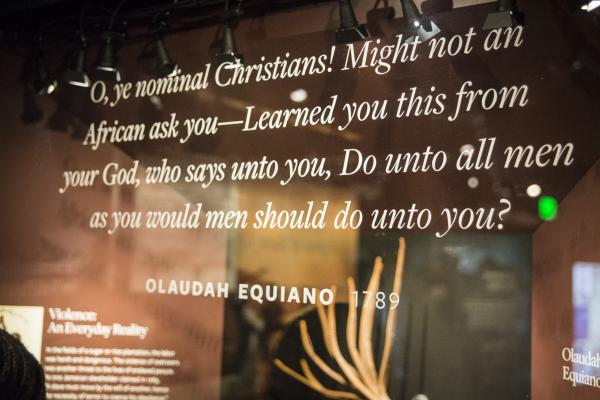The woman in line with me had come to the National Museum of African American History and Culture came from Tulsa, Okla. — a city where both history and present reflect the realities of America.
She was an older African-American woman who knew Terence Crutcher, the 40-year old unarmed black man killed Sept. 16 by a white police officer now charged with manslaughter. The woman in line had been at his mournful prayer service the week before, then flew to Washington for the celebratory opening of this museum.
She knew inside she would see a bit of Tulsa’s history at an exhibit of the 1921 race riot — in Oklahoma City, a riot began when white mobs killed as many as 300 black people and destroyed 35 blocks in one of the wealthiest black neighborhoods in the nation. She had helped provide some the material for the museum.
Her daughter is an Episcopal priest in Baltimore, another of the many communities that knows about the conflagrations of race. Her daughter helps lead a community organization that works to improve housing, increase job opportunities, and rebuild schools and neighborhoods.
All this before we even made it to the front door of the museum. And we were surrounded by massive crowds experiencing both the pain and the promise of the African-American experience in our country.
As an older white man entering this amazing place, I knew I had a lot to learn. I experienced the emotional impact of the museum in different ways than many of those around me.
I know some of the stories of slavery. I had lived through the civil rights era, I was horrified at the deaths of unarmed men and women, and remain horrified at the racism that has bubbled back to the surface in recent years.
I love the stories of singer Marian Anderson and baseball player Jackie Robinson, the depth of the African-American religious experience, and the power of the literature and art that have carried stories of horror and hope across generations.
But for me, these were experiences nestled in my mind. For the folks around me, they were the experiences that touched the core of their beings. But as an American, they are a part of my story — a story that has given our nation great wealth and power from its origins right up until today, at the expense of a people enslaved and exploited.
There is so much to say about the experience of this museum, but let me pick out the stories of four individuals featured there that had particular resonance for me, stories of two white people and two black people.
First, there is the story of Henry Laurens, told succinctly and vividly in a video about the economic impact of slavery in the nation that was becoming the United States.
Henry Laurens became wealthy by being a partner in the mid-1700s in one of the largest slave-trading houses in North America. In one decade, his firm oversaw the sale of more than 8,000 slaves from Africa — and he was a political leader in the Revolutionary War, first serving in the Second Continental Congress and then succeeding John Hancock as president of Congress when it passed the Articles of Confederation in 1777.
Juxtaposed with the story of Henry Laurens is the story of Olaudah Equiano, a slave whose diary from the late 1700s helps give us insight into the conditions of slaves in the colonies that would become the United States.
Equiano was enslaved when he was kidnapped from his home in what is now Nigeria at about the age of 11. Eventually he was sent across the Atlantic with 244 other enslaved Africans to Barbados. He wound up a slave in Virginia, where he was bought by a lieutenant in the British Navy and brought to England. Later he was sold to a Quaker merchant from Philadelphia, who ultimately freed him.
Equiano would write what became the first autobiography of a slave, detailing the horrors of the lives of slaves. The book fueled the anti-slavery movement in Britain, although it was only much later that it had an impact in this country.
At the museum, quotes from his book about the awful conditions on slave ships and for the slaves in their workplaces became vivid additions to the exhibits — and a source of unease from those of us who recognize how we still benefit from those injustices over 250 years ago.
I knew the name Ida B. Wells. As a journalist, I recognized her as one of the towering figures in that profession, a person whose memory is honored in awards to contemporary journalists who help illuminate the systems of racism that pervade our nation.
Ida Wells was born into slavery in 1862, just before the Emancipation Proclamation. Working in Memphis in the 1890s, she documented the lynching of black people in the South, bringing to public attention the way they were used not to punish criminals but to push black people into submission.
Her offices were burned and her life was threatened, but she never gave up, eventually moving to Chicago to continue her work to rid the nation of the evil of the lynching tree. She was also active in the struggle for the rights of women and was one of the founders of the National Association for the Advancement of Colored People.
Then there was a white journalist of the mid-19th century. I could identify with William Lloyd Garrison as someone who could stand as a model for me, a voice for liberation and inclusion, awakening white folks to what was happening to the black folks in their midst.
From 1830 to 1865, he used the power of his writing to rally the nation against the institution of slavery. Early on, he published a column about “the barbarities of slavery.” His newspaper, The Liberator, developed a wide following in the North. He helped organize anti-slavery societies.
And like Wells, he understood the threads that connect the oppression of various groups. When the Civil War was over, he turned his powerful pen to the cause of women’s rights.
As I wound my way up from the depths of the slave trade in the lower levels of the museum to the joy of the music and art on the top floor, I looked through the Corona screen that wraps the beautiful building on what Rep. John Lewis calls “the nation’s front porch.”
On this day, I came back onto that front porch with a new appreciation of the depth and richness of the African-American experience, and a deeper awareness of how that experience made my life what it is.
I also came back onto that front porch with a renewed commitment to help reshape this nation so that it embraces all people instead of exploiting them, elevates everyone instead of crushing them, and creates a place where all can thrive.
The woman from Tulsa and I share a common bond as Americans. If she can find affirmation of her story here and of her hopes, then for those of us who are white the museum offer a place to expand our understanding of our nation — and to work together to overcome the pain and fulfill the promise.
Got something to say about what you're reading? We value your feedback!

